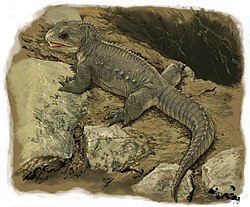| Taxon | Species | Presence | Notes | Images |
|---|
| Aenigmaspina [2] | A. pantyffynnonensis [2] | Geographically present in Pantyffynnon [4] | Remains include osteoderms, vertebrae, ribs and a scapula clustered tightly together, as well as more pieces from the forelimb and additional vertebrae that likely belong to this individual. [2] Nicknamed 'Edgar'. [3] | |
| Clevosaurus [5] | C. cambrica, [5] C. sp. [5] | Geographically present in Pantyffynnon [4] | Partial cranial and post-cranial remains from several specimens, with bite marks belonging to Terrestrisuchus present. [5] |  |
| Crinoidea [5] | Indeterminate [5] | Geographically present in Pantyffynnon [4] | Reworked from older Carboniferous sediments. [5] | |
| Crocodylomorpha [6] | Indeterminate [6] | Geographically present in Pantyffynnon [4] | Isolated bones associated with the holotype of Pendraig . [7] Likely the same animal as Terrestrisuchus | |
| Diphydontosaurus [5] | D. sp. [5] | Geographically present in Pantyffynnon [4] | Left dentary. [5] |  |
| Kuehneosaurus [8] | K. sp. [8] | Geographically present in Pantyffynnon [4] | Indeterminate remains, [9] with Keeble et al. (2018) unable to source this specimen. [5] |  |
| Lepidosauria | Indeterminate | Geographically present in Pantyffynnon [4] | Indeterminate remains. | |
| Pantydraco [10] | P. caducus [10] | Geographically present in Pantyffynnon [4] | Remains include a skull, a partial jawbone, and vertebrae of the cervix, an incomplete right pelvic bone, and partial forelimbs. |  |
| Pendraig [7] | P. milnerae [7] | Geographically present in Pantyffynnon [4] | Remains include a partial pelvis, vertebrae and a left femur that is from the same individual was found disarticulated from the main block. [7] |  |
| Rhynchocephalia [5] | Indeterminate [5] | Geographically present in Pantyffynnon [4] | Represented by one or two indeterminate species. [5] | |
| Terrestrisuchus [8] | T. gracilis, [8] T. sp.? | Geographically present in Pantyffynnon [4] | Several well-preserved articulated partial skeletons and various isolated bones. [8] |  |
|







